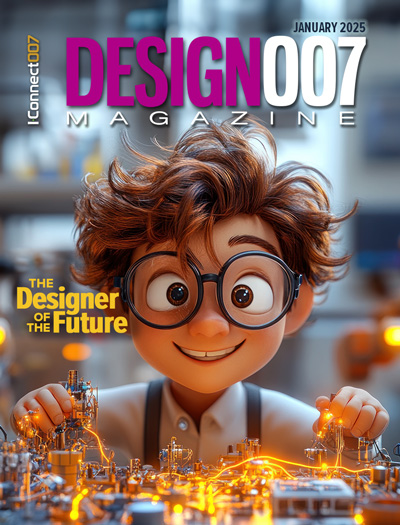-

- News
- Books
Featured Books
- design007 Magazine
Latest Issues
Current Issue
The Designer of the Future
Our expert contributors peer into their crystal balls and offer their thoughts on the designers and design engineers of tomorrow, and what their jobs will look like.

Advanced Packaging and Stackup Design
This month, our expert contributors discuss the impact of advanced packaging on stackup design—from SI and DFM challenges through the variety of material tradeoffs that designers must contend with in HDI and UHDI.

Rules of Thumb
This month, we delve into rules of thumb—which ones work, which ones should be avoided. Rules of thumb are everywhere, but there may be hundreds of rules of thumb for PCB design. How do we separate the wheat from the chaff, so to speak?
- Articles
- Columns
Search Console
- Links
- Media kit
||| MENU - design007 Magazine
Cost-optimize Your PCB Design and Specifications
August 20, 2024 | Erik Pedersen and Richard Koensgen, ICAPE GroupEstimated reading time: 1 minute
Knowledge is the key to identifying the small details that makes the big cost difference for your printed circuit board. There are many types of printed circuit boards and multiple choices between the development of schematic and BOM to PCB technology selection, electronic PCB design, mechanical and physical properties, and PCB specification.
Component Technology and BGA Size
The component size and technology have the most significant influence on the PCB cost. Most surface-mounted microchips can be designed into standard PCBs with plated through-holes. If the same microchip comes in a BGA package, it might need microvias and buried vias using a higher wiring density to be designed into an HDI PCB. Generally, PCBs containing BGAs become HDI PCBs when the ball center-to-center pitch is below 0.8 mm. If your physical board properties allow it and the component availability is equal, you should strive to find the BGA with the largest pitch to reduce the component and PCB cost.
For example, the same BGA microchip can be found with pitch 0.8 mm, 0.6 mm, and 0.5 mm. The 0.8 mm pitch BGA can be routed on an eight-layer standard PCB with a price index of 100. The 0.6 mm pitch can be routed on a (1-6-1) eight-layer, one-step HDI PCB with a price index of 200. The 0.5 mm pitch BGA can be routed on a (2-4B-2) eight-layer, three-step HDI PCB with a price index of 350. The number of lamination steps is the most significant cost driver for HDI and ultra HDI PCBs. Designs with BGAs equal to or less than 0.4 mm and multiple rows challenge the capability of HDI suppliers, which leads to the use of UHDI design parameters and thereby reduces the availability and increases the cost.
Material Selection
Correct material selection that complies with the performance and functionality of your application also plays a crucial role in the PCB cost.
The most common stackups of standard PCBs are specified with 35 µm Cu on all layers. The manufacturer starts on 17.5 µm Cu on outer layers and 35 µm Cu on inner layers, since the final outer layer Cu thickness reaches approximately 35 µm after plating. But 35 µm Cu on the inner layers isn’t always required and can be replaced by 17.5 µm for the current flowing in many electronic devices. This, in turn, lowers costs.
To continue reading this article, which originally published in the August 2024 Design007 Magazine, click here.
Suggested Items
Imagineering, Accutrace Announce Strategic Merger to Enhance Service and Capabilities
01/17/2025 | Newswire.comImagineering Inc., a renowned PCB Fabricator and Assembler, is pleased to announce its merger with Accutrace Inc., a leader in providing time-critical, technologically advanced development and manufacturing services for the electronics industry.
PCB Market Expanding at 3.62% CAGR, To Reach $100 Billion by 2032
01/17/2025 | EINPresswire.comThe global Printed Circuit Board (PCB) Market was valued at US$72.63 billion in 2023 and is projected to exhibit steady growth over the coming years.
See You in Vienna: Speaker Spotlight on PEDC
01/16/2025 | I-Connect007 Editorial TeamVienna, Austria, is known for its amazing architecture, art museums, and classical music scene. But from now on, Vienna might also be known for its PCB design conference. IPC and FED have partnered to create a new PCB design conference in there. The Pan-European Electronics Design Conference (PEDC) takes place Jan. 29-30, 2025 at the NH Danube City hotel in Vienna.
NAMICS Brings Innovative Thermoset Materials to PCB Fabrication
01/16/2025 | Andy Shaughnessy, Design007 MagazineAt PCB Carolina, Matt Lake and Ken Araujo of NAMICS Technologies spoke with Andy Shaughnessy about the introduction of an innovative thermoset material to PCB fabrication. This groundbreaking material, originally developed for the semiconductor packaging industry, addresses a longstanding demand for unreinforced thermoset films that enhance dielectric properties in PCB applications and allow for manufacturing the very finest of features, 0.002" and below.
AIM to Participate in SMTA Ultra High Density Interconnect Symposium
01/15/2025 | AIMAIM Solder, a leading global manufacturer of solder assembly materials for the electronics industry is pleased to announce its participation in the SMTA Ultra High Density Interconnect (UHDI) Symposium, taking place on January 23, 2025 at the Peoria Sports Complex in Peoria, Arizona.


